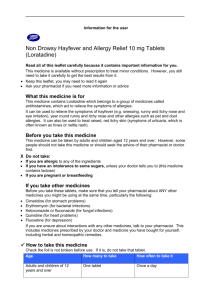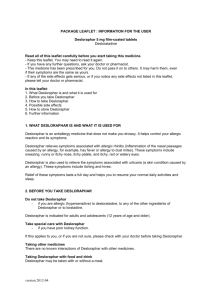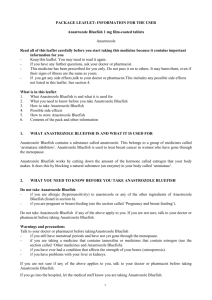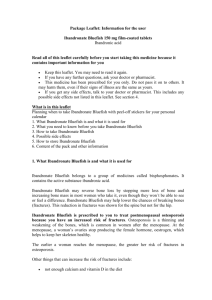Terbinafin Bluefish tablet ENG PL
advertisement
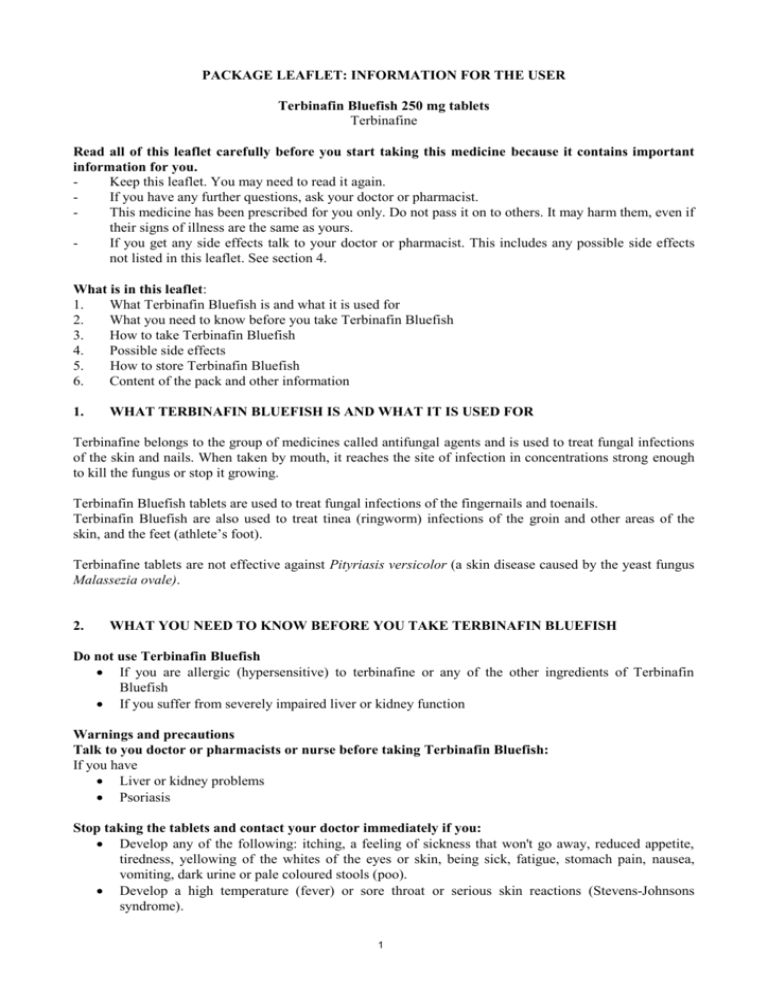
PACKAGE LEAFLET: INFORMATION FOR THE USER Terbinafin Bluefish 250 mg tablets Terbinafine Read all of this leaflet carefully before you start taking this medicine because it contains important information for you. Keep this leaflet. You may need to read it again. If you have any further questions, ask your doctor or pharmacist. This medicine has been prescribed for you only. Do not pass it on to others. It may harm them, even if their signs of illness are the same as yours. If you get any side effects talk to your doctor or pharmacist. This includes any possible side effects not listed in this leaflet. See section 4. What is in this leaflet: 1. What Terbinafin Bluefish is and what it is used for 2. What you need to know before you take Terbinafin Bluefish 3. How to take Terbinafin Bluefish 4. Possible side effects 5. How to store Terbinafin Bluefish 6. Content of the pack and other information 1. WHAT TERBINAFIN BLUEFISH IS AND WHAT IT IS USED FOR Terbinafine belongs to the group of medicines called antifungal agents and is used to treat fungal infections of the skin and nails. When taken by mouth, it reaches the site of infection in concentrations strong enough to kill the fungus or stop it growing. Terbinafin Bluefish tablets are used to treat fungal infections of the fingernails and toenails. Terbinafin Bluefish are also used to treat tinea (ringworm) infections of the groin and other areas of the skin, and the feet (athlete’s foot). Terbinafine tablets are not effective against Pityriasis versicolor (a skin disease caused by the yeast fungus Malassezia ovale). 2. WHAT YOU NEED TO KNOW BEFORE YOU TAKE TERBINAFIN BLUEFISH Do not use Terbinafin Bluefish If you are allergic (hypersensitive) to terbinafine or any of the other ingredients of Terbinafin Bluefish If you suffer from severely impaired liver or kidney function Warnings and precautions Talk to you doctor or pharmacists or nurse before taking Terbinafin Bluefish: If you have Liver or kidney problems Psoriasis Stop taking the tablets and contact your doctor immediately if you: Develop any of the following: itching, a feeling of sickness that won't go away, reduced appetite, tiredness, yellowing of the whites of the eyes or skin, being sick, fatigue, stomach pain, nausea, vomiting, dark urine or pale coloured stools (poo). Develop a high temperature (fever) or sore throat or serious skin reactions (Stevens-Johnsons syndrome). 1 Other medicines and Terbinafin Bluefish Tell your doctor or pharmacist if you are taking or have recently taken other medicines, including medicines obtained without a prescription. Terbinafin Bluefish can affect or be affected by some medicines which contain the following active ingredients: • rifampicin (used to treat tuberculosis) • cimetidine (used to treat stomach ulcers) • tricyclic antidepressants such as clomipramine or amitriptylin • antidepressants called serotonin reuptake inhibitors (SSRI) e.g. paroxetine • certain medicines called monoamine oxidase inhibitors e.g. selegiline used to treat Parkinson´s disease. • beta receptor blockers (used to treat high blood pressure and some heart conditions) • antiarrhythmics (medicines used to treat heart irregular heart beat) • cyclosporine (a medicine used to control your body’s immune system in order to prevent rejection of transplanted organs) • fluconazole, ketoconazole (medicines used to treat fungal infections) • amiodarone (medicine to treat heart problems) • caffeine If you are taking the oral contraceptive pill while taking Terbinafin Bluefish, break-through bleeding and irregular periods may occur. Pregnancy, breast-feeding and fertility Ask your doctor or pharmacist for advice before taking any medicine. Do not take Terbinafin Bluefish if you are pregnant unless specifically advised by your doctor. Do not take Terbinafin Bluefish if you are breast-feeding as it passes into breast milk. Driving and using machines Terbinafin Bluefish has no or negligible effect on the ability to drive a car or operate machinery. 3. HOW TO TAKE TERBINAFIN BLUEFISH Always take Terbinafin Bluefish exactly as your doctor or pharmacist has told you. You should check with your doctor or pharmacist if you are not sure. Dosage is determined by the doctor who will adjust it to your individual needs. The usual dose for adults (including the elderly) is one 250mg tablet once daily. The length of your course of treatment will depend on the nature and severity of infection. Usual course lengths are as follows: Athlete's foot, ringworm, ringworm of the groin Take for 2-4 weeks. Some types of athlete's foot may require up to 6 weeks treatment. Signs of the infection may not disappear until several weeks after completing the course of treatment. Nail infection Fingernails: usually take for 6 weeks. Toenails: usually take for 12 weeks but in some cases up to 6 months. Terbinafine Bluefish is not recommended for children and adolescents (less than 18 years of age). If you find that Terbinafin Bluefish has too strong or too weak an effect, contact your doctor or pharmacist. If you take more Terbinafin Bluefish than you should If you have taken more Terbinafin Bluefish than you should, or if children have been taking medicine by accident, please contact your doctor or the hospital to get an opinion of the risk and advice on action to be 2 taken. If an overdose has been taken there may be signs such as headache, feeling sick, upper chest pain and dizziness. If you forget to take Terbinafin Bluefish If you forget to take your tablet(s), take them as soon as you can. Do not take a double dose to make up for a forgotten dose. If you have any further questions on the use of this product, ask your doctor or pharmacist. 4. POSSIBLE SIDE EFFECTS Like all medicines, this medicine can cause side effects, although not everybody gets them. The following side effects have been reported in connection with treatment with Terbinafin Bluefish: Very common (occur in more than 1 in 10 users): loss of appetite, indigestion, diarrhoea, feeling bloated, stomach ache, feeling sick, allergic skin rashes, itching, joint or muscle pain Common (occur in more than 1 in 100 users): headache, feeling unwell Uncommon (occur in fewer than 1 in 100 users): taste loss or taste disturbances Rare (occur in fewer than 1 in 1000 users): anaphylactic reactions (serious allergic reactions), angioneurotic oedema (swelling of the lips, face, throat or tongue), serious liver problems including severe liver failure, hepatic enzymes increase. Very rare (occur in fewer than 1 in 10,000 users): worsening of existing psoriasis, serious skin reactions such as Stevens-Johnson syndrome (severe widespread reddening and blistering), toxic epidermal necrolysis (peeling of the surface layer of skin), pustular drug eruption and toxic pustuloderma, hair loss, changes or reduction of numbers and types of certain blood cells (detected through blood tests, bruising or repeated infections such as colds or sore throats), menstrual disturbance (breakthrough bleeding and irregular cycle), cause or worsening of existing skin or systemic lupus erythematosus (large areas of red skin patches, fatigue, dizziness, sensation of tickling, tingling, burning, pricking and partial loss of sensitivity Not known (cannot be estimated from the available data) blood creatinine phosphokinase increased, inflammation of the pancreas, hearing impairment, ringing of the ears, inflammation of blood vessels, inability to perceive odor, jaundice (signs include yellowing of the whites of the eyes or skin) or inflammation of the liver, oversensitivity to light, depression, anxiety, influenza like illness and high temperature You should see your doctor immediately if you experience symptoms of angioedema, such as: • swollen face, tongue or pharynx • difficulty to swallow • hives and difficulties to breath Reporting of side effects If you get any side effects talk to your doctor or pharmacist or nurse. This includes any possible side effects not listed in this leaflet. You can also report side effects directly via the national reporting system listed in Appendix V. By reporting side effects you can help provide more information on the safety of this medicine. 5. HOW TO STORE TERBINAFIN BLUEFISH Keep this medicine out of the sight and reach of children. This medical product does not require any special storage conditions. 3 Do not use Terbinafin Bluefish after the expiry date which is stated on the carton. The expiry date refers to the last day of that month. Medicines should not be disposed of via wastewater or household waste. Ask your pharmacist how to dispose of medicines no longer required. These measures will help to protect the environment. 6. CONTENTS OF THE PACK AND OTHER INFORMATION What Terbinafin Bluefish contains The active substance is terbinafine. Each tablet contains 250 mg terbinafine (as terbinafine hydrochloride). The other ingredients are microcrystalline cellulose, sodium starch glycolate (type A), hypromellose, colloidal andhydrous silica and magnesium stearate. What Terbinafin Bluefish looks like and contents of the pack Terbinafin Bluefish 250 mg tablets are white, circular, biconvex tablets with “TF” on one side and a score line on the other side. Pack sizes: 7, 10, 14, 20, 28, 30, 49, 50, 56, 60, 98, 100, 112, 250 and 500 tablets in blister pack. Not all of the pack sizes may be marketed. Marketing Authorisation Holder and Manufacturer Bluefish Pharmaceuticals AB Torsgatan 11 111 23 Stockholm Sweden This medical product is authorized in the member states of the EEA under the following names: Denmark: Terbinafin Bluefish Finland: Terbinafin Bluefish Iceland: Terbinafin Bluefish Norway: Terbinafin Bluefish Sweden: Terbinafin Bluefish This leaflet was last revised in 21 May 2015 4





